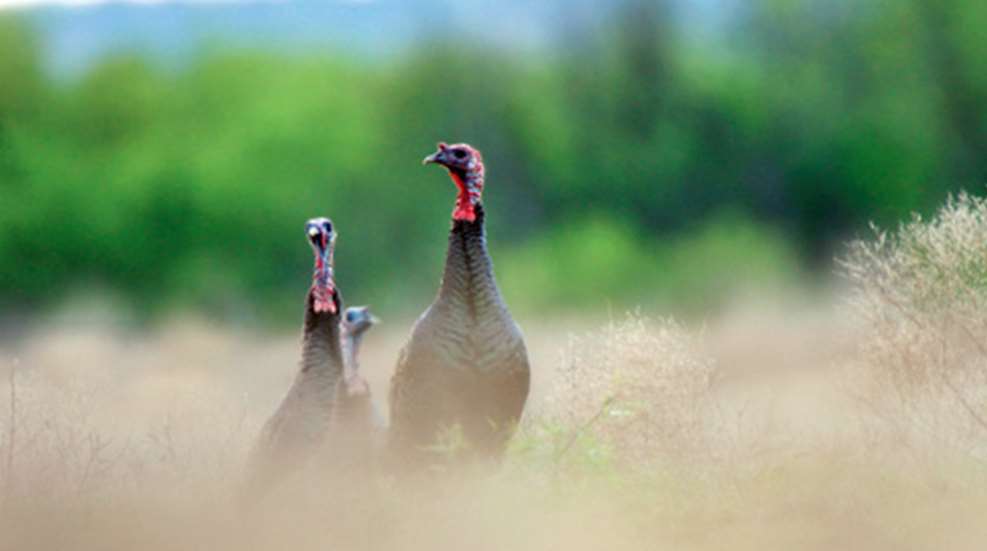
The mature male wild turkey is among the most confounding, unpredictable, maddening creatures that have ever walked the woods of America. People who seek him—especially during spring gobbling season—are nothing short of masochists. Webster’s defines that word as “taking pleasure in being abused or dominated.”
’Course, one man’s abuse is another’s abject pleasure. A lot of the folks who read these pages revel in getting up early enough to be in a stand of mature hardwoods before first light. In the blackness they use the unaided voice to mimic the call of a barred owl (some of us cheat and use a crow call or some such), hoping to trigger a replying gobble from a tom still yawning in his treetop roost.
It’s so unfair how we humans use our superior knowledge and technology to home in on a horny, fat, wattled old bird (a mature gobbler will weigh 18 to 30 pounds or more) that just wants to have its way with as many svelte hens as it can attract with its swaggering, tail-fanning strut. Once you’ve got a gobbler pinpointed, all you do is close within 75 yards or so without being spotted, park your camouflaged carcass against a broad tree and unlimber your calls. Make a little music with a cedar-box scraper, mouth-mounted diaphragm call or wing-bone, enjoy the thunderous, ringing gobbles that tell you your quarry is headed your way for some morning
delight and hold onto your shotgun.
Uh-huh.
Well, there are a few other little elements, some fine points of this exciting game. For one, the wild tom turkey has eyesight approaching the capabilities of an intergalactic stellar observatory. Move a muscle—no matter how many mosquitoes decide to explore your nostrils or whether your groin becomes the new home of a deer tick—and you’re dead meat.
Oh, and it may well be that, despite your best owl-hooting and hen-yelping, the toms in that patch of woods may simply be grumpy or otherwise out of sorts and just unwilling to communicate. Or they may already be well shacked-up and satisfied. Or maybe it’s your deodorant or lack thereof. Who knows? Point is, grown-up gobblers are a curmudgeonly, unreliable lot and frustration is often the reward for seeking them.
Nonetheless, hunting them in the lovely woods of springtime is nothing less than a fine and pleasant misery! And every once in a while, just to keep you on the hook, a hunt turns out so ringingly successful … but more about that later.
First, a profile of a hunt that was typical in its outcome but unique in many aspects of its execution. Here’s how it started:
Me ’n Squirrel stumbled from our bunks at an ungodly hour, made a quick pot of coffee in the galley, grabbed our Berettas and stepped from the deck of our houseboat onto a waiting bass boat. We were going “fishing” for turkeys.
The hardwood forests of central West Virginia—prime turkey habitat—are dotted with sizable lakes, one of them named Stonewall Jackson. Its shorelines are largely undeveloped and blessed with large wildlife management areas. In spring, wise hunter/anglers hitch up ol’ Twinkleflake, launch it before first light and find a likely shoreline to talk turkey. And oh, yes, did I mention that on this lake you actually can rent a houseboat on which you can headquarter and roam at will?
As you might suspect, gobbler season is also prime time to toss a lure for largemouth bass. No self-respecting West Virginian launches a boat without bass tackle aboard, and the fish don’t care if he or she is in full camo. Make a cast and toot a hen call. What a life!
Well, me ’n Squirrel (also known as guide Brian Hager) reversed that order of action, setting up on a hillside above an arm of Jackson Lake. Despite some fine calling by Squirrel and an alluring hen decoy out in front, nothing happened until 11:30 a.m. when we were about to dump the guns and break out the fishing tackle. Apparently responding to the calling, two large birds flew across the water to our side and hauled butt uphill straight toward our deke.
Sweat plastered my face mask to my cheeks and burned my eyes, bugs explored various orifices and my heart pounded, but I moved nary a muscle. The lead bird sashayed up to the decoy, 20 yards from the front of my barrel. It looked like a young tom, but I saw it only from the neck up because grass hid its chest. I wanted that bird bad, but I just couldn’t be sure. A few minutes later two heads bobbed over a rise and were gone.
That hunt, a few seasons back, is typical of my turkey trips—and probably yours. But this past season, a friend and I had a different kind of experience that will linger long in what’s left of my mind.
Tom Franklin and I used to work together at The Wildlife Society, a conservation organization with a long history dedicated to the wise management of this country’s wildlife resources. Over the years we’ve done what we could to keep fish and critter populations within the bounds of their habitat.
April and May of ’09 made for the wettest spring in decades in the hills of central Virginia. The constant, heavy rains had the mountain streams raging and seemed to have put a serious damper on the mating ardor of the turkeys—or at least the gobblers’ willingness to tell the world about it.
So Tom and I weren’t expecting a lot of noise as we parked my old Jeep Cherokee in the middle of a cow pasture and headed for a place I’d chosen while deer hunting the previous fall. We weren’t 50 yards from the rig when the first gobble rang out from the direction in which we were headed. We pussyfooted maybe another 50 yards along a dim path and set up with our backs to big old trees.
Now, right here I probably ought to own up to something: Over many decades of springtime woods wandering, I had always relied on friends like Tom to do the honors with turkey calls; they were so good at it, I guess I got spoiled. But last spring I vowed to roll my own. I bought a trio of calls and a DVD with excellent calling directions, and on a series of April mornings ventured into various woodlots near my central Virginia home.
The crow call attracted only crows, so I set up in a variety of likely spots where I’d seen turkeys the previous fall, trying to mimic the hen-turkey sounds I’d learned from the video. After a couple of hours I became thoroughly convinced I had either terrorized or insulted every single gobbler in that part of the county, so I dusted myself off and headed out of the woods. At its edge, a large red-wattled tom got up and flew. Maybe there was hope for me yet.
Now, only a week later, Tom and I were experiencing the stuff of dreams. As we sat in camouflaged silence at least four different toms, parked on the limbs of large pines in open woods just over the lip of a rise before us, announced the new day with a nonstop barrage of gobbles. The woods seemed to vibrate.
Well, it stood to reason: The white-headed old boys were just voicing all the pent-up ardor of days and days of rain-enforced chastity. I couldn’t blame them for being flat-out hot-to-trot.
My partner and I had been taking in this woodland crescendo—and getting pretty randy ourselves—for at least half an hour when the tenor of the gobbling became somewhat muted. The change almost certainly meant the birds had flown down from their roosts, though I had not heard the distinctive whooshing sound of those big wings. Tom began a series of soft but enticing hen sounds, answered almost immediately by a salvo of gobbler talk.
They were coming.
Given that I was still in turkey-talking kindergarten, I wasn’t about to mess up this situation by tooting a call. But Tom motioned for me to join in, so I mouthed three or four tentative yelps. Incredibly, two heads bobbed into view as the birds topped the rise out front. They weren’t exactly running, but they weren’t lollygagging either.
I shut up, as did Tom. These two old hornyheads sure looked committed—and they were. The lead bird was well within range of both of us, but closer to my partner, when he let fly. One down.
The other turkey hotfooted it away but, true to the breed’s unpredictability, stopped and peered back. Apparently curious about his partner’s strange spastic dance in the leaves, he began to creep back my way in that hesitant head-forward posture. Thankfully, the bead of my Remington 870 was on his head when he cleared a tree at about 25 yards. His final resting place was not 6 feet from my partner’s trophy.
This kill would have been a trophy to me even if his beard had been little more than stubble. This one’s was 11 inches long, as was Tom’s—a matching pair.
The ensuing high fives, back slaps and cheek-stretching grins were a fitting end to a memorable hunt.





































